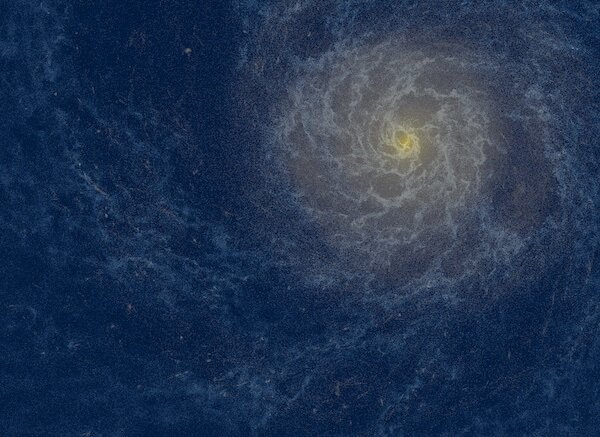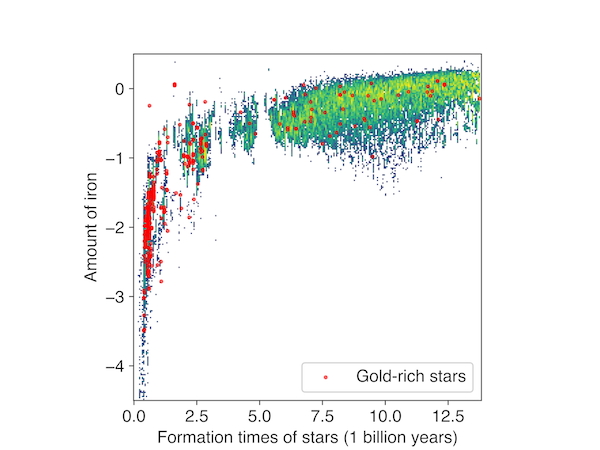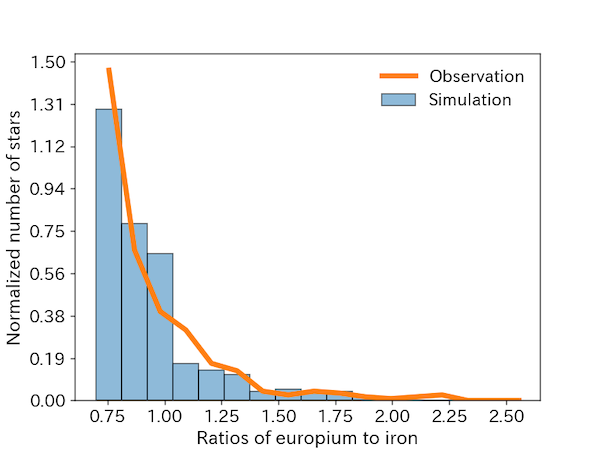NEWS
Gold-rich Stars Came from Ancient Galaxies
Stars are the reason our planet contains a diverse cohort of elements. Most elements heavier than iron came about from the rapid neutron-capture process (r-process) in the Milky Way, including "jewelry store elements" such as gold and platinum.
Now, an international research team, led by Yutaka Hirai from Tohoku University and the University of Notre Dame, have discovered the birthplace of the stars that produced some of these heavier elements. Most gold-rich stars, according to the research, formed over 10 billion years ago in small, building-block galaxies--known as progenitor galaxies--of the Milky Way.
Their findings were published in the Monthly Notices of the Royal Astronomical Society on November 14, 2022.
Over the past five years, hundreds of gold-rich stars have been detected by state-of-the-art telescopes worldwide. The myriad of elements in stars reflects the star-formation history of galaxies. Stars synthesized elements and distribute them into space at the end of their lifetimes. Gas clouds enriched by newly synthesized elements formed next-generation stars. The mystery was when, where, and how these stars formed
The team tracked the Milky Way's formation from the Big Bang to the present with a numerical simulation. This simulation has the highest time resolution to date, capable of pinpointing the cycle of materials formed by stars in the Milky Way.

A visual representation of the distribution of stars and gas in a Milky Way formation simulation used in this study. The yellow dots represent stars, and the blue and white diffuse clouds depict gas. ©Yutaka Hirai
Using the supercomputer ATERUI II in the Center for Computational Astrophysics at the National Astronomical Observatory of Japan, the team successfully ran the simulation over the course of several months, making it possible--for the first time--to analyze the formation of gold-rich stars in the Milky Way.
A movie based on the author's test simulation. ©Takayuki Saitoh
The simulation revealed that some progenitor galaxies contained large amounts of the heaviest elements. A neutron star merger--where nucleosynthesis occurs and produces heavy elements--increased the abundance of the heaviest elements in these small galaxies. The predicted plentifulness matches with previous observations.

A distribution of europium to iron ratios. The blue histogram shows the simulated stars of the Milky Way, whereas the orange shows the observed stars. ©Yutaka Hirai et al.
"The study's findings open a new avenue for extracting the fossil records of stars," said Hirai. "The gold-rich stars today tell us the history of the Milky Way."
Looking ahead, Hirai and his team plan to simulate the Milky Way formation and clarify the origins of individual stars with the help of the recently debuted Fugaku supercomputer.

Iron amounts as a function of simulated stars' formation times. Red plots represent stars enhanced in heavy elements, whereas the green color gradation shows all stars. ©Yutaka Hirai et al.
Publication Details:
Title: Origin of highly r-process-enhanced stars in a cosmological zoom-in simulations of a Milky Way-like galaxy
Authors: Yutaka Hirai (Tohoku University/University of Notre Dame), Timothy C. Beers (University of Notre Dame), Masashi Chiba (Tohoku University), Wako Aoki (National Astronomical Observatory of Japan), Derek Shank (University of Notre Dame), Takayuki R. Saitoh (Kobe University), Takashi Okamoto (Hokkaido University), Junichiro Makino (Kobe University)
Journal: Monthly Notices of the Royal Astronomical Society
DOI: 10.1093/mnras/stac2489
Contact:
Yutaka Hirai
Tohoku University/University of Notre Dame
Email: yutaka.hirai * astr.tohoku.ac.jp (Replace * with @)
Website: https://www.astr.tohoku.ac.jp/~yutaka.hirai/index.html




